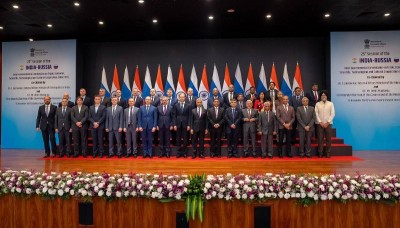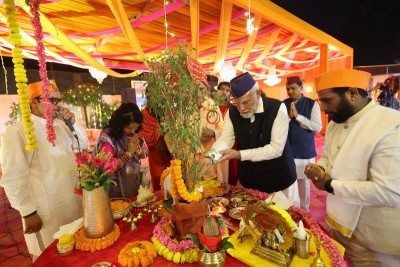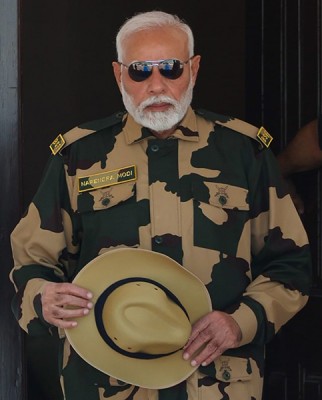
NSCN-K: Unsettled Equations
Earlier, on August 13, two NSCN-K militants, identified as Azheto Sumi and Khekato Chophy, were killed in an encounter with 31 AR personnel in the Tamatai area near Longsa village in the Mokokchung District of Nagaland. The SFs recovered one AK-56 rifle along with 42 live rounds; one .22 pistol (country made) and one live round; three Chinese grenades; as well as other items from the possession of the slain militants.
On July 21, 2015, a NSCN-K militant, identified as '2nd lieutenant' Tokihe Yepthomi was killed in the jungle of Puliebadze in the Kohima District of Nagaland. The Security Forces (SFs) recovered a 9mm sub-machine-carbine, one .32 pistol, four assorted gun & pistol magazines, 81 rounds of assorted ammunition, three Chinese grenades, two Improvised Explosive Device (IED) and two Military Grade Anti-Tank (AT) Mines from the incident site.
On June 9, 2015, in retaliation to the June 4, 2015, Chandel attack, Indian troops carried out surgical strike 'inside' Myanmar, inflicting 'significant damage and casualties' to militant outfits, purportedly the NSCN-K. Though no official figure was released about the number of militants killed in the operation, credible media reports put the number anywhere between seven and 18 (though some of the more fanciful suggest 100 militant fatalities in the operation).
The NSCN-K along with the Kanglei Yawol Kanna Lup (KYKL) and Kangleipak Communist Party (KCP) had claimed the June 4, 2015, Chandel attack, the worst single attack targeting SFs, in terms of fatalities, in the entire Northeast region since 1982. In the June 4 attack, 18 Army personnel were killed and another 11 were injured when militants ambushed a convoy of 46 troopers of the 6 Dogra Regiment of the Army, at Moltuk, near the India-Myanmar border, in the Paralong area of the Chandel District of Manipur.
The SFs launched an offensive against the NSCN-K soon after the June 4, 2015,Chandel attack. Since then, according to partial data compiled by the South Asia Terrorism Portal (SATP), SFs have killed at least 12 NSCN-K militants (all data till September 13, 2015), excluding the indeterminate number killed during the June 9operation 'inside Myanmar'. Among those neutralized were 'captain' Wangchuk and '2nd lieutenant' Tokihe Yepthomi. SFs also arrested 16 NSCN-K militants, including 'health minister-cum-political advisor' Ngamsinlung Panmei and 'captain' Atokaalias Kughahoto Sema.
The NSCN-K militants have, however, failed to inflict a single casualty among SFs since the launch of the offensive, although they have carried out 10 attacks on SF personnel. However, the outfit was responsible for the killing of 27 SF personnel between March 27, 2015, when the outfit unilaterally withdrew from the 2001 ceasefire, and June 4, 2015. The worst attack targeting SFs during this period, on May 3, 2015, was the twin ambush by NSCN-K militants resulted in the death of eight SF personnel - seven of them from the 'C' company of 23 AR and another from the 164 Naga Territorial Army (TA) Battalion - about three kilometres from Changlangshu village in the Tobu Subdivision, near the India-Myanmar border, in the Mon District of Nagaland. Another nine troopers were injured in the incident.
Although the outfit has not been involved in any incident of killing of civilian population since the abrogation of the ceasefire in March 27, 2015, it was reported that two school students were killed in crossfire between AR and NSCN-K cadres at Phor village in Meluri subdivision in the Phek District of Nagaland on July 16, 2015.
The NSCN-K along with the Isak-Muivah faction of National Socialist Council of Nagaland (NSCN-IM) was formed on April 30, 1988, when the principle split within the parent National Socialist Council of Nagaland (NSCN) took place. Clannish divisions among the Nagas (Konyak and Tangkhul) were the primary reason behind the split. The Konyak and Pangmei (Naga tribes largely found in Myanmar) formed the NSCN-K under the leadership of Khole Konyak and 'Chairman' S.S. Khaplang. NSCN-IM constituted the mainly Tangkhul faction, and was led by 'president' Isak Chisi Swu and T. Muivah. Other leaders of the undivided NSCN-K were 'general secretary' N. Kitovi Zhimomi and 'publicity secretary' Akaho Asumi. The NSCN-Ksplit further in 2011 when two senior founding leaders of the outfit N. Kitovi Zhimoni, the Ato Kilonser (Prime Minister) and Khole Konyak, broke away to form a new group called Khole-Kitovi faction of NSCN (NSCN-KK).
On April 28, 2001, NSCN-K had signed a ceasefire with the Government of India (GoI). The NSCN-KK signed a ceasefire agreement with GoI on April 27, 2012 and on April 27, 2015, this was extended for another year.
Significantly, on March 27, 2015, NSCN-K unilaterally exited the ceasefire, declaring that "any 'meaningful peace and political interaction' between the two entities (NSCN-K and GoI) should be premised on the concept that Nagas were sovereign people". Soon after, the Reformation faction of NSCN (NSCN-R) was formed on April 6, 2015, by two senior 'kilonsers' (ministers), Wangtin Konyak, also known as Y. Wangtin Naga, and T. Tikhak. The duo had attended the ceasefire supervisory board (CFSB) meeting at Chumukedima (Dimapur) on March 27, 2015, defying S.S. Khaplang's diktat and was consequently 'expelled'. A ceasefire agreement with NSCN-R was signed on April 27, 2015.
The ceasefire with NSCN-K, which was only enforceable within Nagaland, had hardly been peaceful. According to partial data compiled by SATP, the outfit was involved in at least 282 fatalities (25 civilian, eight SF personnel and 249 militants) between April 28, 2001, (the date of signing of the ceasefire agreement) and March 27, 2015, (the date of abrogation of the ceasefire) in Nagaland, Assam, Manipur, and Arunachal Pradesh.
Though SFs have succeeded in minimizing the immediate threat from NSCN-K, the danger remains very much alive. Indeed, almost all the fatalities and arrests since March 27, 2015, have been reported from three northeastern States: Nagaland, Manipur and Arunachal Pradesh (barring the fatalities in the June 9 operation which was reportedly carried out inside Myanmar territory). These three states border Myanmar, where the top NSCN-K leadership and overwhelming proportion of cadres are reported to have taken shelter.
On April 9, 2012, NSCN-K had signed a ceasefire agreement with the Myanmar Government. The agreement provided NSCN-K members with the freedom to move 'unarmed' across the country. On July 22, 2015, Union Minister of State for Home Affairs Kiren Rijiju told Rajya Sabha, "As per inputs received, NSCN (K) has stationed small groups of its cadres at various strategic locations in Nagaland and Arunachal Pradesh. Most of these groups have sneaked into Indian Territory from across the Indo-Myanmar Border." The present strength of NSCN-K is estimated at about 1,500. According to reports, around 1,000 of these cadres are in Myanmar. In a worrying development, an AR communiqué stated that 15 youths from Phek District in Nagaland were forcefully taken away by cadres of NSCN-K's 'Mobile-V' group. The group operates between Phek in Nagaland and Tsera in Myanmar, under 'brigadier' Kurichu Pochury. The AR PRO stated, "These youths have been taken to Tsera camp in Myanmar, from where they are being sent to Ngiakching camp (Myanmar) for basic military training."
Significantly, on July 16, during the first India-Myanmar Joint Consultative Commission (JCC) Meeting held in New Delhi, India reportedly asked Myanmar to hand over four top NSCN-K leaders, including its chief S.S. Khaplang, 'military commander' Niki Sumi, 'brigadier' Kurichu Pochury, and 'kilonser' Y. Asang. Meanwhile, on September 10, 2015, the National Investigation Agency (NIA) investigating the June 4, 2015, Chandel attack, announced a cash reward of INR 700,000 and INR one million for any information about the whereabouts of S.S. Khaplang and Niki Sumi respectively.
Moreover, NSCN-K has joined hands with three of the most active terror outfits in the Northeast: the United Liberation Front of Asom-Independent (ULFA-I); IK Songbijit faction of the National Democratic Front of Bodoland (NDFB-IKS); and Kamtapur Liberation Organisation (KLO), to form the United National Liberation Front of Western South East Asia (UNLFWESEA). The Front, created on April 17, 2015, and headed by S. S. Khaplang, was formed with the aim to set up a 'northeast government-in-exile', reportedly to be based in Myanmar.
Worryingly, just two days after the August 28, 2015, Pangsha incident, NSCN-K's 'ministry of information and publicity (MIP)' had warned that "'August 28 Pangsha massacre' of unarmed NSCN/GPRN [Government of People's Republic of Nagaland] members and 'innocent civilians' by Indian Army shall bear testimony before the world for generations to come" and warned the "enemy agents that the worst fate awaits them to face judgments and NSCN-K would leave no stones unturned to prosecute them under anti-national act (sic)." According to a September 10, 2015, report, intelligence agencies have issued an alert that 48 highly trained NSCN-K militants, led by Chailai Pansa and Bopa Wangnao, were presently camping in the Lahu village of Tirap District in Arunachal Pradesh to carry out attacks on Indian Forces in retaliation against the August 28, 2015, Pangsha incident. An AR medical team was fired upon by NSCN-K militants on September 10, 2015, on the way to organizing medical camps at Pongkhungri and Avangkhu in the Phek District of Nagaland. The team escaped unharmed.
The situation is compounded by a measure of ambiguity in the Government's strategy to deal with the NSCN-K. On July 11, 2015, Union Home Minister Rajnath Singh had categorically dismissed any move to re-initiate negotiation with the group, declaring, "The Government will not talk to criminal groups. It was not the Government but the [NSCN-K] which had unilaterally withdrawn itself from the ceasefire. It was unfortunate. It should not have done so. Now the Government is doing what is required to do (sic)." However, on August 21, 2015, Union Minister of State for Home Affairs Kiren Rijiju stated, "Some other groups also requested the Centre and me that they may be permitted to go to Myanmar to talk to the NSCN (K). We said if there are efforts being made from the civil society to impress upon any militant group, including the NSCN (K), to cease violence, we have no objection." Finally, a delegation of Naga Mothers' Association (NMA) met with the top leaders of NSCN-K on August 31, 2015, at an NSCN-K camp situated a few kilometres inside Myanmar and appealed to NSCN-K leaders to renew the cease fire. According to NMA, NSCN-K responded 'positively', saying they were not averse to the resumption of the ceasefire.
An early stabilization of the situation is, however, unlikely. The peace accordsigned between GoI and NSCN-IM on August 3, 2015, has unsettled long-established equations of power between the various Naga militant formations, and the Government has failed to project a formulation that could bring the NSCN-K back to the table with the prominence that its leadership believes it deserves. Escalating violence and seeking to bring diverse extremist formations in the Northeast under a single umbrella are initiatives evidently intended to improve the NSCN-K's negotiating strength. Further, since the organisation's principle infrastructure and cadre base lies in safe havens in Myanmar and is under no urgent threat - notwithstanding the showcasing of the June 9 operation 'inside Myanmar', a few kilometers beyond a non-existent border - the incentive to intensify the spiral of violence certainly remains.
Support Our Journalism
We cannot do without you.. your contribution supports unbiased journalism
IBNS is not driven by any ism- not wokeism, not racism, not skewed secularism, not hyper right-wing or left liberal ideals, nor by any hardline religious beliefs or hyper nationalism. We want to serve you good old objective news, as they are. We do not judge or preach. We let people decide for themselves. We only try to present factual and well-sourced news.







